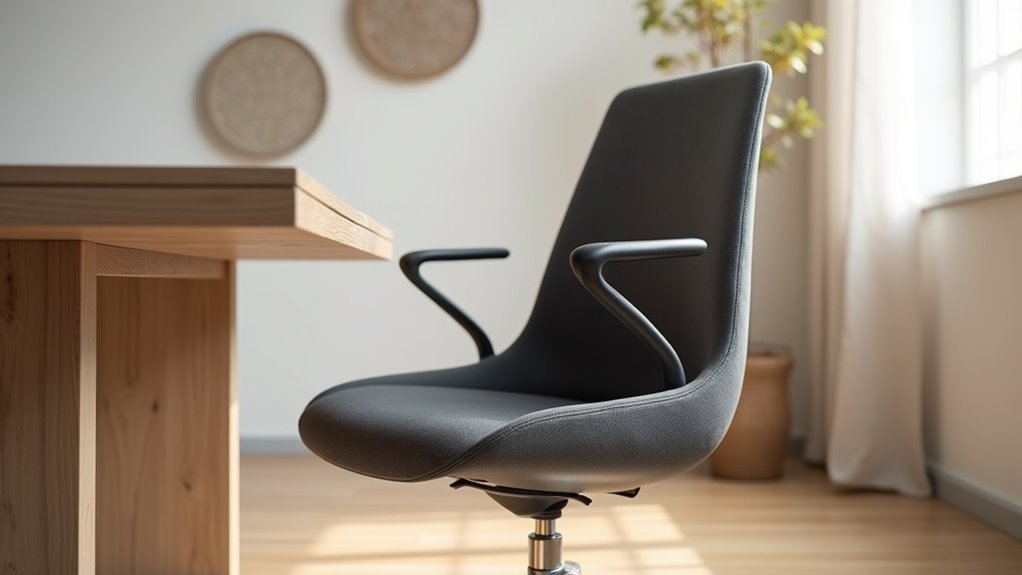How to Sit in a Desk Chair
This post contains affiliate links. As an Amazon Associate, we earn from qualifying purchases.
To sit comfortably in a desk chair, adjust the height so your knees bend at a 90-degree angle and your feet rest flat on the floor. Make sure to leave a 2-4 inch gap between the chair edge and your knees for optimal blood flow, and ensure the lumbar support fits snugly against your lower back for spinal health. Additionally, position your armrests correctly to enhance your overall comfort. Further details and tips for maximizing your seating experience will be provided later in the article.
Essential Facts in 30 Seconds
- Adjust chair height for 90-degree knee angle and flat feet.
- Keep a 2-4 inch gap between chair edge and back of knees.
- Position lumbar support against lower back for spinal curve.
- Set armrests to the height of bent elbows for relaxed shoulders.
- Sit back in the chair with pelvis slightly tilted forward for alignment.
Seat Height and Foot Placement
Your desk chair is set. Let’s talk about seat height and foot placement. Adjust your chair so your knees bend at a 90-degree angle. This helps keep your joints safe. The seat should be just below your kneecaps. This position gives your thighs a comfortable spot.
If your feet dangle, use a footrest. A footrest keeps your feet flat and stable. This helps with blood flow too. Remember, your knees should be at or just below hip level. This helps prevent back pain. Proper office ergonomics can also play a significant role in enhancing your overall comfort and productivity throughout the day. Additionally, maintaining good posture while seated is crucial for long-term health. Proper height adjustment is essential for reducing thigh pressure and aiding blood circulation. Adjusting the chair height correctly can also prevent slouching and promote better posture.
Check your armrests. They should be the right height. If they’re too high or low, it can mess up your setup.
Think of your chair like a puzzle. You need all the pieces to fit together.
Now you’re ready to sit comfortably. No more slouching or fidgeting!
Seat Depth and Thigh Support

Sitting comfortably in your desk chair depends on the right seat depth. Think of it like finding the best shoes. Proper seat depth boosts comfort and supports your thighs. It also helps relieve pressure. Ergonomic chairs are designed to enhance comfort during prolonged sitting, making it easier to maintain good posture. Additionally, selecting a chair with adjustable features can further improve your sitting experience. A well-adjusted chair can significantly enhance your overall comfort level.
Here’s how to find the right fit:
- Measure your thigh length: Sit back against the chair. Measure from your hips to about 2 inches behind your knees.
- Aim for a gap: Keep a 2-4 inch space between the chair edge and your knees. This gap helps with blood flow and reduces pressure.
- Adjust if needed: If your chair can change depth, experiment until you find what feels best. Ensuring proper seat depth also aids in promoting a healthier sitting posture.
Getting this right reduces discomfort and helps you focus. Less pain means fewer trips to the chiropractor.
Check your chair today. Your thighs will appreciate it!
Lumbar Support and Pelvic Position
Your desk chair can be a great friend for comfort and focus. Start by adjusting the lumbar support. It should fit snugly against your lower back. This keeps your spine’s natural curve. A good fit reduces strain and keeps you comfy during long study sessions. With features like 5 adjustable positions, the Click5 Lumbar Support ensures that you can customize your support for maximum comfort. Regular cleaning of your chair can also contribute to maintaining hygiene and mobility. Additionally, proper lumbar support can significantly reduce musculoskeletal issues that may arise from poor sitting posture. Maintaining proper sitting posture is essential for long-term comfort and health.
Next, check your pelvic position. Tilt your pelvis slightly forward. This helps your spine stay in a good position. It also spreads your weight evenly. Your hips and thighs will feel less pressure.
Adjust the chair height so your feet rest flat on the floor. Your thighs should be parallel to the ground. A chair that tilts slightly forward can help keep everything aligned.
Get ready to sit comfortably. Your back will appreciate it!
Backrest Usage and Posture Support

Here are three important things to think about:
- Adjustability: A backrest should fit your height and width. It needs to support your back while you work. Proper chair height adjustment is essential for optimal support, as it allows for correct sitting posture that promotes overall health.
- Material Choices: Look for a backrest made from soft, breathable materials. This helps spread out pressure and keeps you comfy. Choosing the right materials also contributes to enhanced comfort throughout the day.
- Support Areas: Your backrest must support both your lower and upper back. Good support keeps your spine aligned and reduces discomfort during long hours. Additionally, the backrest should maintain the natural curve of the spine to prevent aches and promote overall comfort.
With the right backrest, you’ll feel less stress on your body. You can work better and feel good while you sit.
Make a smart choice, and get ready to enjoy your time at your desk!
Armrests and Upper Body Position
The right armrests for your desk chair can make a big difference. Proper armrests boost comfort and help you concentrate. Set your armrests at the same height as your bent elbows. This keeps your shoulders relaxed.
Check the width of the armrests. Too narrow can feel cramped, and too wide can force your arms to spread out uncomfortably. Aim for a fit that supports your forearms without making you lean or shrug. Adjustable features are essential for achieving the perfect armrest setup. Properly adjusted armrests should promote good posture and enhance your overall seating experience.
Adjustable armrests are key. Being able to change the height and width helps you find your perfect fit. With the right setup, your upper body feels great. Say goodbye to neck and shoulder pain. Additionally, proper armrest height contributes to overall comfort and reduces strain during long hours of sitting.
Take a moment to adjust your armrests. You’ll notice the difference!
Frequently Asked Questions
How Often Should I Adjust My Chair for Optimal Comfort?
Reevaluate your chair adjustments every 3 to 6 months. This keeps your comfort levels high. Notice discomfort? Make adjustments right away. Your body deserves support. Good posture helps prevent pain. A well-adjusted chair promotes better focus and productivity. Don’t ignore signs of discomfort. Regular adjustments lead to a happier work experience. Prioritize your seating for better health.
What Are the Signs of an Improperly Adjusted Chair?
Discomfort is often ignored. An improperly adjusted chair can cause problems. Is your chair too high or too low? This can lead to tingling, ongoing pain, or bad posture. These are warning signs from your body.
A chair should fit you well. The right height helps your feet touch the ground. Your knees should be at a 90-degree angle. Seat depth matters too. If it’s too deep, it can push your knees up. This can cause discomfort.
Pay attention to your body. If you feel pain or tingling, your chair might be wrong for you. Adjust your chair today. A small change can make a big difference. Comfort is key for better focus and productivity.
Can I Use a Cushion for Better Support?
Using a cushion can improve your support while sitting. Different types of cushions, like memory foam and gel, provide comfort and help with posture. These cushions can reduce discomfort, especially during long hours of sitting. They mold to your body shape and distribute weight evenly. This means less pressure on your back and hips. Choosing the right cushion can make a big difference. A good cushion helps you feel better and more relaxed. Enjoy sitting comfortably with the right support!
Is It Important to Take Breaks While Sitting?
Sitting for long periods can slow down your mind. Taking breaks helps you feel better. It can boost your productivity. Short breaks refresh your focus. This leads to better work and greater well-being.
Research shows that short breaks can increase overall performance. A quick walk or stretch can do wonders. Your body and mind need movement. Standing up can improve blood flow. This keeps you alert and ready to work.
Try to take a break every hour. Just five to ten minutes is enough. Use this time to relax or do something fun. Your work will benefit from these small pauses. Remember, breaks are not a waste of time. They are essential for better work and health.
How Can I Improve My Posture While Sitting?
Improving posture while sitting is important for your health. Start by adjusting your chair height. Your feet should rest flat on the floor. Use a cushion or lumbar support for your lower back. This helps keep your spine straight.
Try simple exercises to strengthen your muscles. Shoulder rolls can relieve tension. Gentle stretches help keep you flexible. Take short breaks throughout the day. Stand up and walk around to reset your body.
Conclusion
Now that you know how to sit correctly, it’s time to put it into practice. Think of your chair as your spaceship. Adjust the seat height so your feet touch the floor. Your feet should feel stable, like rockets ready to launch.
Use the lumbar support to keep your back comfortable. It helps you sit up straight. Rest your arms on the armrests. This gives your arms a break and helps you relax.
With these tips, you will sit well and feel great. You can focus better and work harder. Enjoy your time in your chair!
